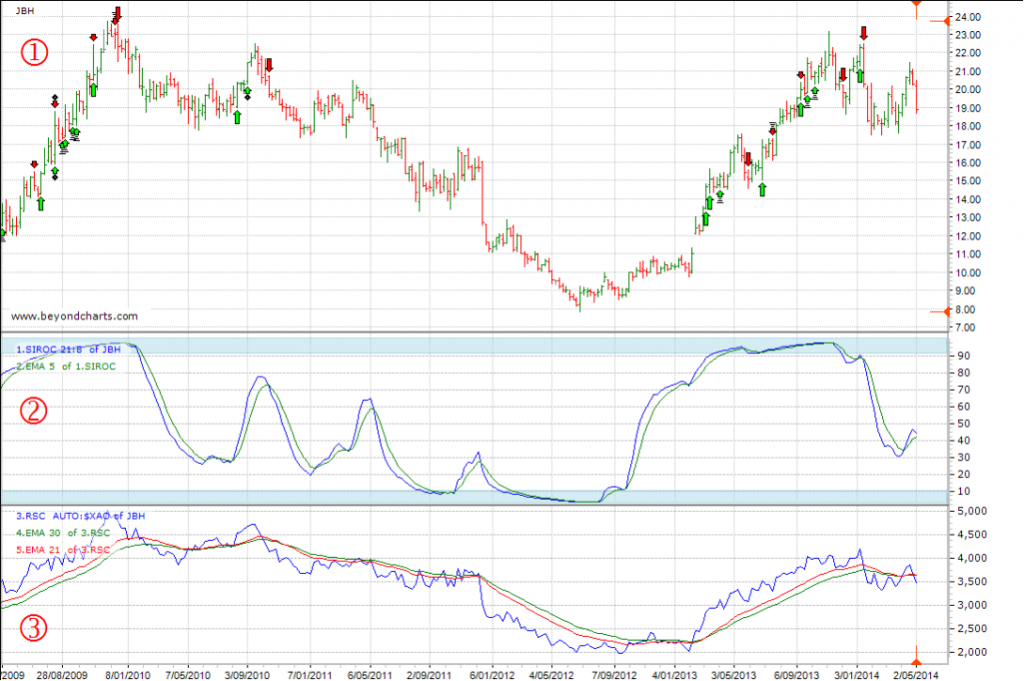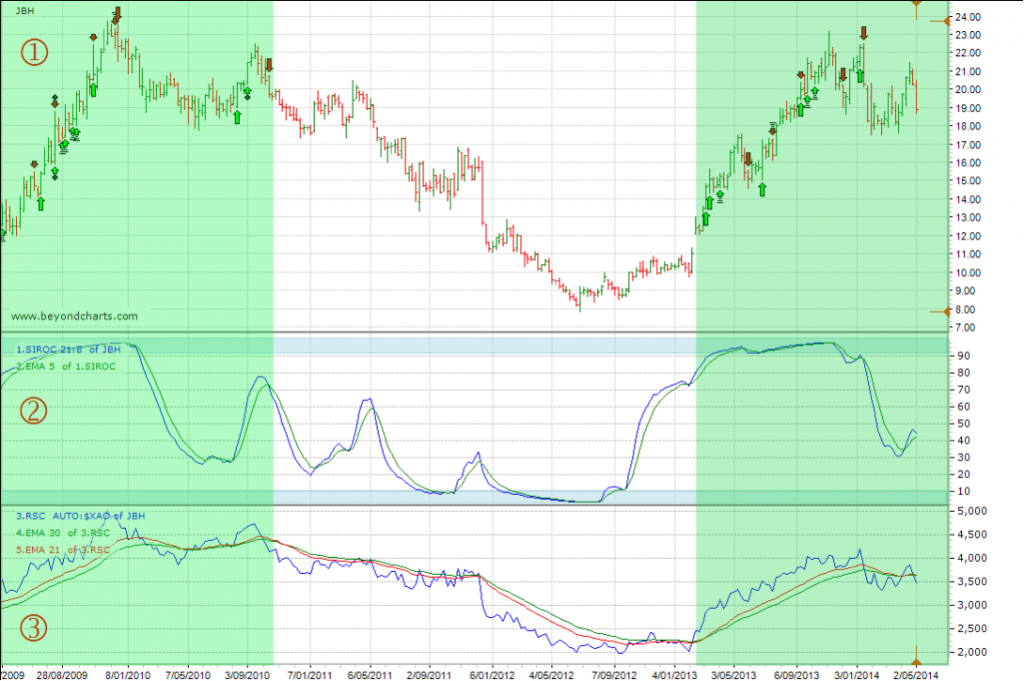This article has been prepared in response to a comment made by Shawn 30.04.2014
“Hi Gary
May I ask what the SIROC momentum indicator actually is?”
A vital aspect of being able to trade the markets successfully is a trader’s ability to recognise trade set-ups and market moves. Just like a ship captain who bases his decisions on the ebb and flow of the tide and direction of wind, a trader uses technical analysis to recognise the up and downward cycles of individual stocks and overall market direction.
Technical indicators are widely used to identify these cycles as their algorithmic nature, in combination with a securities price action, can be monitored and measured with a formula.
One of the more commonly used types of indicators, are momentum indicators. Momentum and Rate Of Change indicators show trend direction by rising while an uptrend is continuous or falling while a down trend is continuous. For the trader, a momentum indicator can help identify if a security is performing above or below its average.
To understand the benefit of using a momentum indicator and to respond to the comment above, in this blog I explain the use the indicator at the heart of the SPA3 trading system – the SIROC. SIROC stands for Smoothed Index Rate Of Change. When combined with the Relative Strength Comparison indicator, SPA3 can identify the stocks that are on the rise and outperforming the market.
The SIROC is indexed between 0 -100 which makes determining the overbought and oversold zones more objective to the trader. In comparison to other momentum indicators, the SIROC shows more consistent and smoother slopes, peaks and troughs, making it easier to see which stocks are sitting within the overbought or oversold zones.
For those familiar with technical analysis indicators, the SIROC can be viewed as a combination of a MACD and an RSI or Stochastic. It has the smoothness of the MACD and the indexing of the RSI or Stochastic.
For the purpose of this post, I’m going to focus on the practical workings of the indicator. For those not familiar with technical analysis or momentum indicators, don’t worry, SPA3 does the analysis automatically.
The image below of JB Hi-Fi contains 3 separate charts, first is the weekly price chart (1), the middle chart is the SIROC indicator (2) and the bottom chart is the RSC – Relative Strength Comparison (3).
Let’s take a closer look at the SIROC chart or chart (2). The blue line is the SIROC and the green line is a 5 week exponential moving average (EMA) of the SIROC. When the blue line of the SIROC crosses above the green line (EMA 5), it means that the stock’s price momentum is positive. When the blue line of the SIROC crosses below the green EMA line, then the stock’s price momentum is negative. As investors, we are looking for the periods when the SIROC is positive as this is an indication of continued price strength.
A core objective of the SPA3 system is to outperform the market and as such, the SIROC indicator is not used just on its own. There are instances where a security is rising but the index is rising faster. This is why the SIROC indicator is used in conjunction with the RSC indicator.
The RSC indicator is the blue line represented in chart (3). When the RSC is above its EMA it suggests that the stock is outperforming the overall market. When the RSC is below its EMA it suggests that the stock is underperforming the broader market. So, we want to avoid the periods when the stock is underperforming and buy the stock when it is outperforming.
We now combine the use of the SIROC and the RSC. When the RSC is outperforming, and the SIROC is showing positive momentum we take buy signals which are generated by the SPA3 system.
On the chart of JBH above, you can clearly see the buy (green) and sell (red) signals displayed in chart (1) during 2009 and 2013. However, throughout much of 2010 -2012, JBH was in a clear down trend retracing some 50% from its peak. Although the SIROC indicator did experience some short term rises during this period, due to a small number of rallies, JBH was underperforming the market index (as seen by the RSC in the chart (3) declining and tracking below the EMA). As securities must be outperforming the market for SPA3 to consider buying, JBH was not a consideration.
Eventually the tide turned and in March 2013 JBH began rising faster than the market index. Shortly afterwards, a medium term buy signal was generated by SPA3 and JBH was considered again. JBH continued outperforming the market with a strong SIROC until late in 2013.
The SIROC indicator helps identify securities that are rising in the medium term and the RSC complements it by ensuring that they are outperforming the market.





8 Responses
Always good to get amplified information on basic TA and how it’s integrated into SPA3.
Hi Gary,
Enjoyed the article, I Know the weekly price chart(#1)is available in GPS in the SPA3 system, are charts 2 and 3 also available and if so where can I find them?
Steven, As a SPA3 user, you are delivered the above layout as an Overlay key. Simply open the overlays panel on the right of GPS and apply the F9 key from the relevant SIROC group that you use.
Any dramas with this, please contact the helpdesk.
Ahh – priceless explanation Gary – I hope this is not gleamed from the SPA White Paper as I was unable to find this information represented so clearly as you have here. Thanks
Wow! Thanks for the reply, Gary. Very nice of you. It is much clearer to me now.
I suppose the SIROC & RSC are proprietary indicators, and as such you cant detail how exactly they are constructed?
Thanks again
Shawn
Response to Comment by Shawn:
The RSC is not. It’s a simple comparative ratio between the stock an the index achieved by dividing the one by the other.
The SIROC is and it isn’t. There are formulae available in the public domain for the SIROC. However, the one that we use is proprietary in that it was engineered to overcome problems with other versions of the SIROC.
Regards
Gary
Hi Gary,
Thanks for the very interesting blog post about the SIROC indicator. I understand the concept of a smoothed rate of change indicator (SROC), but haven’t quite come to understand the indexing part of SIROC (i.e. the I in SIROC).
What does “indexed” mean and how is it calculated?
Regards
Steven
Response to Comment by Steven on 2/7/14:
“Indexed” in this context means indexed between 0 and 100 meaning that the indicator value cannot be < 0 or > 100.
If you compare the SIROC to indicators such as the MACD and ROC which oscillate above and below the 0 line, their values don’t have upper and lower limits.
The RSI and Stochastic are also indexed indicators that cannot rise above 100 or fall below 0.
Indexed indictors lend themselves to far more easily define “overbought” and “oversold” zones in a far more objective manner than non-indexed indicators.
In terms of ‘indexing’ a result, this can typically be achieved, in most cases not all, by dividing a ‘result’ into 100 and then subtracting it from 100.
Best Regards
Gary